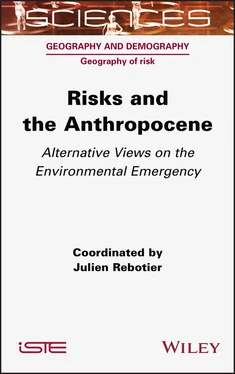Davis, H. and Todd, Z. (2017). On the importance of a date, or decolonizing the Anthropocene. ACME: An International Journal of Critical Geographies , 16(4), 761–780.
Demeritt, D. (2001). The construction of global warming and the politics of science. Annals of the Association of American Geographers , 91(2), 307–337.
Di Mauro, S. (2015). Postface. In Espace et rapports de domination , Clerval, A., Fleury, A., Weber, S., Rebotier, J. (eds). PUR, Rennes.
Douglas, M. and Wildavsky, A. (1983). Risk and Culture: An Essay of the Selection of Technological and Environmental Dangers . University of California Press, Berkeley, CA.
Dufour, S. (2015). Sur la proposition d’une géographie physique critique. L’Information Géograhique , 79, 8–16.
Dufour, S. and Lespez, L. (2019). Les approches naturalistes en géographie, vers un renouveau réflexif autour de la notion de nature ? BAGF , 96(2), 319–343.
Ekers, M. and Loftus, A. (2012). Revitalizing the production of nature thesis: A Gramscian turn? Progress in Human Geography , 37(2), 234–252.
Ferdinand, M. (2019). Une écologie décoloniale – Penser l’écologie depuis le monde caribéen . Le Seuil, Paris.
Ferry, L. (1992). Le nouvel ordre écologique . Grasset, Paris.
Fressoz, J.-B. and Bonneuil, C. (2015). L’Événement Anthropocène . Le Seuil, Paris.
Gandy, M. (2015). Écologie Queer. Nature, sexualité et hétérotopies . Eterotopia, Paris.
GAR (2015). Réduction de risques de catastrophe : bilan mondial [Online]. Available at: www.preventionweb.net/english/hyogo/gar/2015/en/gar-pdf/GAR2015_FR.pdf[Accessed 23 May 2020].
García Acosta, V. and Musset, A. (eds) (2018). Les catastrophes et l’interdisciplinarité . L’Harmattan, Paris.
Gautier, D. and Benjaminsen, T.A. (2012). Environnement, discours et pouvoirs. L’approche political ecology . Quae, Paris.
Gemenne, F., Rankovic, A., Ansart, T., Martin, B., Mitrano, P., Rio, A. (2019). Atlas de l’Anthropocène . Presses de Sciences Po, Paris.
Haraway, D. (2016). Anthropocene, capitalocène, plantationocène, chtulucène. Faire des parents. Multitudes , 4(65), 75–81.
Hornborg, A. (2017). Dithering while the planet burns: Anthropologist’s approaches to the Anthropocene. Reviews in Anthropology , 46(2–3), 61–77.
Hulme, M. (2009). Why We Disagree About Climate Change: Understanding Controversy, Inaction and Opportunity . Cambridge University Press, Cambridge.
Keucheyan, R. (2014). La nature est un champ de bataille. Essai d’écologie politique . Zone, Paris.
Kull, C. and Batterbury, S. (2017). La place de l’environnement dans les géographies anglophones et francophones. Émergence, transformations et circulations de la political ecology . In Humanités environnementales. Enquêtes et contreenquêtes , Blanc, G., Demeulenaere, E., Feuerhan, W. (eds). Publications de la Sorbonne, Paris.
Latour, B. (1991). Nous n’avons jamais été modernes . La Découverte, Paris.
Latour, B. (2015). Face à Gaïa . La Découverte, Paris.
Latour, B. (2017). Où atterrir ? Comment s’orienter en politique . La Découverte, Paris.
Lavell, A. and Maskrey, A. (2014). The future of disaster risk management. Environmental Hazards , 13(4), 267–280.
Lewis, S. and Maslin, M.A. (2015). Defining the Anthropocene. Nature , 519(7542), 171–180.
Lorimer, J. (2017). The Anthroposcene: A guide for the perplexed. Social Studies of Science , 47(1), 117–142.
Lövbrand, E., Beck, S., Chilvers, J., Forsyth, T., Hedrén, J., Hulme, M., Lidskog, R., Vasileiadou, E. (2015). Who speaks for the future of Earth? How critical social science can extend the conversation on the Anthropocene. Global Environmental Change , 32, 211–218.
Lovelock, J. and Margulis, L. (1974). Atmospheric homeostasis by and for the biosphere: The Gaia hypothesis. Tellus , 26(1–2), 2–10.
Malm, A. and Hornborg, A. (2014). The geology of mankind? A critique of the Anthropocene narrative. The Anthropocene Review , 1(1), 62–69.
Marsh, G.P. (1865). Man and Nature; or Physical Geography as Modified by Human Action . C. Scribner, New York.
Maskrey, A. (ed.). (1993). Los desastres no son naturales . La Red, Panama [Online]. Available at: www.desenredando.org/public/libros/1993/ldnsn/LosDesastresNoSonNaturales-1.0.0.pdf[Accessed 8 May 2020].
Mathieu, N. and Jollivet, M. (1989). Du rural à l’environnement. Penser les changements socio-écologiques . L’Harmattan, Paris.
Mercer, J. (2012). Knowledge and disaster risk reduction. In The Routledge Handbook of Hazards and Disaster Risk Reduction , Wisner, B., Gaillard, J-C., Kelman, I. (eds). Routledge, New York.
Metzger, P. (2017). Connaissances et relations de pouvoir : les sciences sociales, les risques et l’environnement. HDR Thesis, Université Grenoble Alpes, Grenoble.
Metzger, P. and Robert, J. (2015). Environnement et risques : les sciences sociales piégées entre critique radicale et utilité sociale. In Espaces et rapports de domination , Clerval, A., Fleury, A., Rebotier, J., Weber, S. (eds). PUR, Rennes.
Moore, J. (2003). Capitalism as world-ecology. Braudel and Marx on environmental history. Organization and Environment , 16(4), 431–458.
Moore, J. (2017a). The Capitalocene part I: On the nature and origins of our ecological crisis. The Journal of Peasant Studies , 44(3), 594–630.
Moore, J. (2017b). Confronting the popular Anthropocene. Toward an ecology of hope. New Geographies , 9, 186–191.
Moore, J. (2017c). The road to ruin? Making sense of the Anthropocene. IPPR Progressive Review , 24(3), 176–202.
Moore, J. (2018). The Capitalocene part II: Accumulation by appropriation and the centrality of unpaid work/energy. The Journal of Peasant Studies , 45(2), 237–279.
Mumford, L. (1950). Technique et civilisation . Le Seuil, Paris.
O’Brien, K., Eriksen, S., Nygaard, L.P., Schjolden, A. (2007). Why different interpretations of vulnerability matter in climate change discourses. Climate Policy , 7(1), 73–88.
O’Keefe, P., Westgate, K., Wisner, B. (1976). Taking the naturalness out of natural disasters. Nature , 260(5552), 566–567.
Oliver-Smith, A., Alcántara-Ayala, I., Burton, I., Lavell, A. (2017). The social construction of disaster risks: Seeking root causes. International Journal of Disaster Risk Reduction , 22, 469–474.
Pahl-Wostl, C. (2009). A conceptual framework for analysing adaptive capacity and multi-level learning processes in resource governance regimes. Global Environmental Change , 19(3), 354–365.
Palsson, G., Szerszynski, B., Sörlin, S., Marks, J., Avril, B., Crumley, C., Hackmann, H., Holm, P., Ingram, J., Kirman, A., Pardo Buendía, M., Weehuizen, R. (2013). Reconceptualizing the “Anthropos” in the Anthropocene: Integrating the social sciences and humanities in global environmental change research. Environmental Science and Policy , 28, 3–13.
Читать дальше












